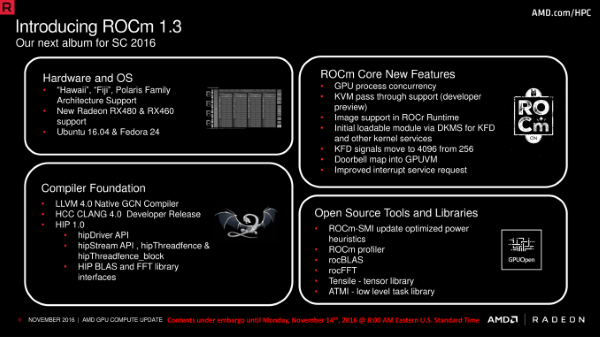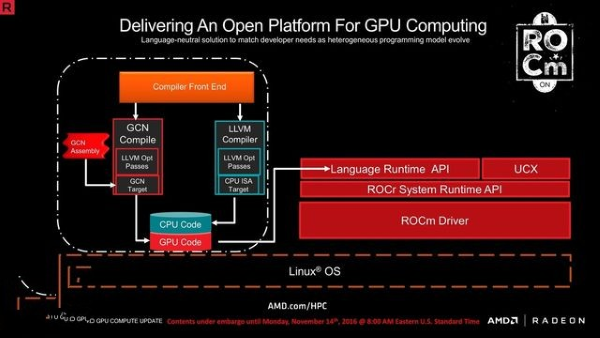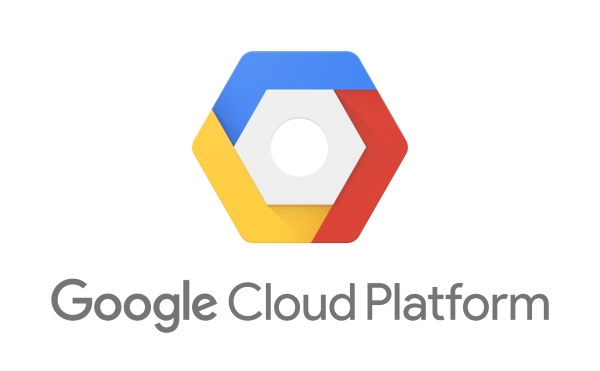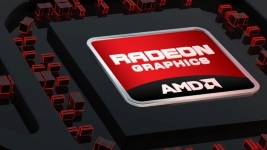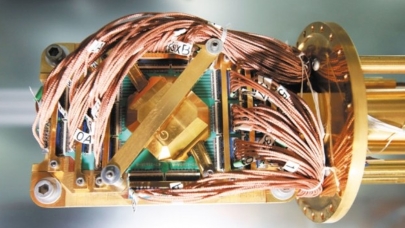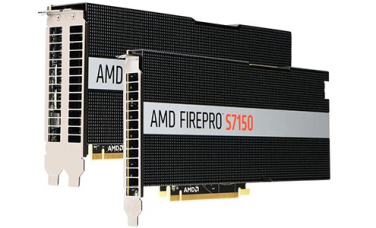
AMD chose SC16 to announce the release of the Radeon Open Compute Platform (ROCm) featuring software support of new Radeon GPU hardware, new math libraries, and a rich foundation of modern programming languages, designed to speed development of high-performance, energy-efficient heterogeneous computing systems.
AMD also announced planned support of OpenCL and for a wide range of CPUs in upcoming releases of ROCm, including support for AMD’s upcoming “Zen”-based CPUs, Cavium ThunderX CPUs, and IBM Power 8 CPUs. The advances further cement ROCm’s position as a very versatile open source platform for GPU computing.
“Radeon Open Compute is a platform for a new era of GPU problem-solving, designed to harness the power of open source software to unlock new solutions for HPC and hyperscale computing,” said Raja Koduri, senior vice president and chief architect, Radeon Technologies Group, AMD. “Today’s release of ROCm gives developers consummate flexibility in where and how they use GPU compute. We’re excited to show off some of these incredible applications at SC16.”
“An open source approach to heterogeneous computing can help bring the benefits of high-performance computing directly to developers, providing the flexibility for them to use available compute resources and extract the best possible performance from their available hardware,” said Denise Dumas, vice president, Platform Engineering, Red Hat. “As a leader in helping to nurture and maintain open source communities, we are pleased to see that AMD has elected to take a community-focused approach to ROCm.”
“The combination of AMD’s GPU support of ThunderX along with the breadth of features of the ROCm software release is a valuable addition to Cavium’s overall solution for the HPC and Hyperscale server market,” said Larry Wikelius, Vice President of the Software Ecosystem and Solutions Group at Cavium, Inc. “Today’s announcement by AMD is an excellent complement to the innovative features of ThunderX that include 48 ARMv8 cores, integrated I/O and dual socket configuration support that our customers and partners are deploying today in these markets”
The new release of ROCm introduces a wide range of updates, including:
- Expanded GPU support – ROCm now supports all Polaris architecture-based graphics products, including the Radeon RX460, 470 and 480 graphics cards, and the Radeon Pro WX 7100, 5100 and 4100 GPUs, growing the rich portfolio of devices supported by ROCm devices. The Polaris architecture is specifically designed to benefit low-level programming, helping developers to extract the most from the hardware.
- ROCm Virtualization of the GPU hardware via OS Containers and Linux’s Kernel Virtual Machine (KVM) – ROCm now supports Docker containerization, allowing end-users to simplify the deployment of an application in ROCm-enabled Linux server environments. ROCm also supports GPU Hardware Virtualization via KVM pass-through to allow the benefits of hardware-accelerated GPU computing in virtualized solutions.
- Heterogeneous Compute Compiler (HCC) – HCC is a single source ISO C++ 11/14 compiler for both CPU and GPU, with support for the C++17 “Parallel Standard Template Library”. It is built on a rich compiler infrastructure including LLVM-based GCN ISA code generation with assembler and disassembler support.
- Heterogeneous-Compute Interface for Portability (HIP) – HIP enables developers to port CUDA applications to ROCm using HIPIFY which automates the conversion to the HIP kernel language and runtime API, creating portable applications that can run on virtually any GPU using either NVIDIA’s CUDA Compiler or HCC.
- New Math Acceleration Libraries – ROCm introduces support for new advanced math acceleration libraries with support for BLAS, FFT and N-dimensional tensor contractions.
The new version of Radeon Open Compute is available here.
AMD also announced that Radeon GPU technology will be available to Google Cloud Platform users worldwide. Starting next year, Google will use AMD’s fastest available single-precision dual GPU compute accelerators, Radeon-based AMD FirePro S9300 x2 Server GPUs, to help accelerate Google Compute Engine and Google Cloud Machine Learningservices. AMD FirePro S9300 x2 GPUs can handle highly parallel calculations, including complex medical and financial simulations, seismic and subsurface exploration, machine learning, video rendering and transcoding, and scientific analysis. Google’s Cloud Platform will make the AMD GPU resources available for all their users around the world.
“Graphics processors represent the best combination of performance and programmability for existing and emerging big data applications,” said Raja Koduri, senior vice president and chief architect, Radeon Technologies Group, AMD. “The adoption of AMD GPU technology in Google Cloud Platform is a validation of the progress AMD has made in GPU hardware and our Radeon Open Compute Platform, which is the only fully open source hyperscale GPU compute platform in the world today. We expect that our momentum in GPU computing will continue to accelerate with future hardware and software releases and advances in the ecosystem of middleware and libraries.”
© HPC Today 2024 - All rights reserved.
Thank you for reading HPC Today.

